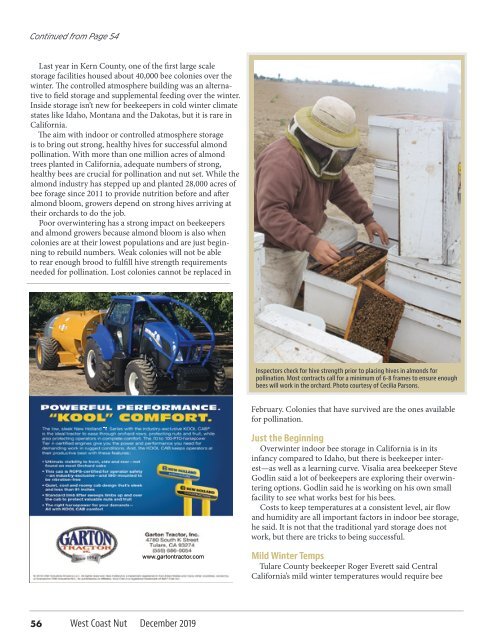WCN December 2019
You also want an ePaper? Increase the reach of your titles
YUMPU automatically turns print PDFs into web optimized ePapers that Google loves.
Continued from Page 54<br />
Last year in Kern County, one of the first large scale<br />
storage facilities housed about 40,000 bee colonies over the<br />
winter. The controlled atmosphere building was an alternative<br />
to field storage and supplemental feeding over the winter.<br />
Inside storage isn’t new for beekeepers in cold winter climate<br />
states like Idaho, Montana and the Dakotas, but it is rare in<br />
California.<br />
The aim with indoor or controlled atmosphere storage<br />
is to bring out strong, healthy hives for successful almond<br />
pollination. With more than one million acres of almond<br />
trees planted in California, adequate numbers of strong,<br />
healthy bees are crucial for pollination and nut set. While the<br />
almond industry has stepped up and planted 28,000 acres of<br />
bee forage since 2011 to provide nutrition before and after<br />
almond bloom, growers depend on strong hives arriving at<br />
their orchards to do the job.<br />
Poor overwintering has a strong impact on beekeepers<br />
and almond growers because almond bloom is also when<br />
colonies are at their lowest populations and are just beginning<br />
to rebuild numbers. Weak colonies will not be able<br />
to rear enough brood to fulfill hive strength requirements<br />
needed for pollination. Lost colonies cannot be replaced in<br />
Inspectors check for hive strength prior to placing hives in almonds for<br />
pollination. Most contracts call for a minimum of 6-8 frames to ensure enough<br />
bees will work in the orchard. Photo courtesy of Cecilia Parsons.<br />
T5<br />
100-PTO-horsepower<br />
www.gartontractor.com<br />
February. Colonies that have survived are the ones available<br />
for pollination.<br />
Just the Beginning<br />
Overwinter indoor bee storage in California is in its<br />
infancy compared to Idaho, but there is beekeeper interest—as<br />
well as a learning curve. Visalia area beekeeper Steve<br />
Godlin said a lot of beekeepers are exploring their overwintering<br />
options. Godlin said he is working on his own small<br />
facility to see what works best for his bees.<br />
Costs to keep temperatures at a consistent level, air flow<br />
and humidity are all important factors in indoor bee storage,<br />
he said. It is not that the traditional yard storage does not<br />
work, but there are tricks to being successful.<br />
Mild Winter Temps<br />
Tulare County beekeeper Roger Everett said Central<br />
California’s mild winter temperatures would require bee<br />
56<br />
West Coast Nut <strong>December</strong> <strong>2019</strong>


















